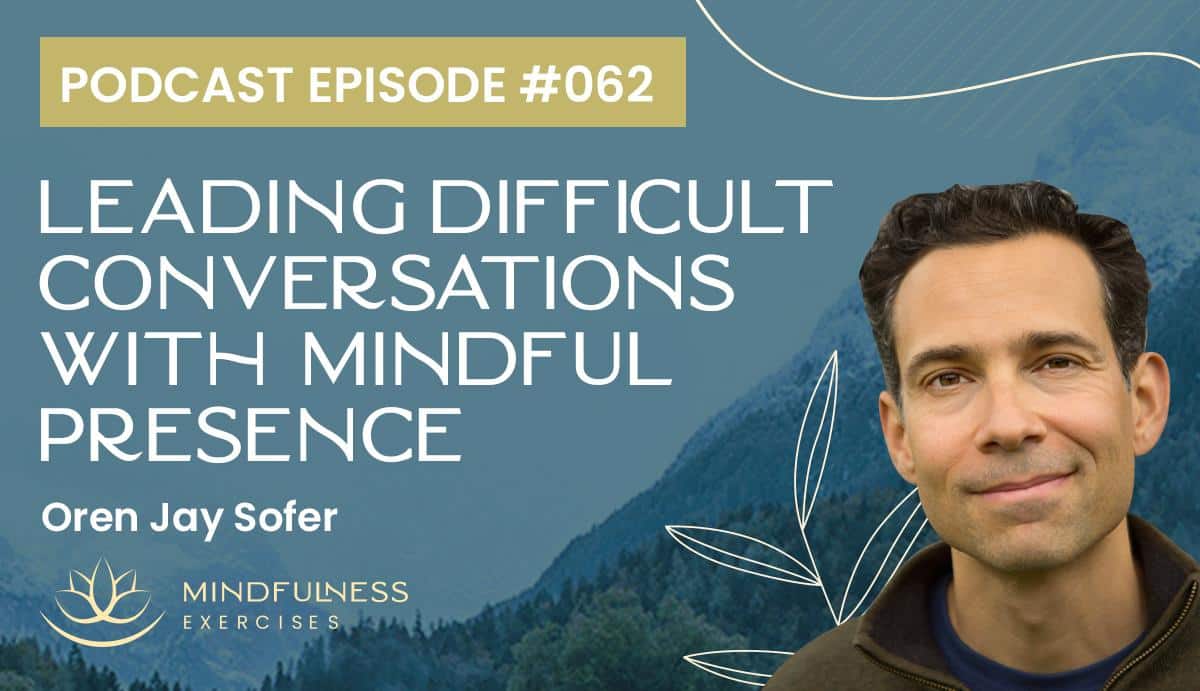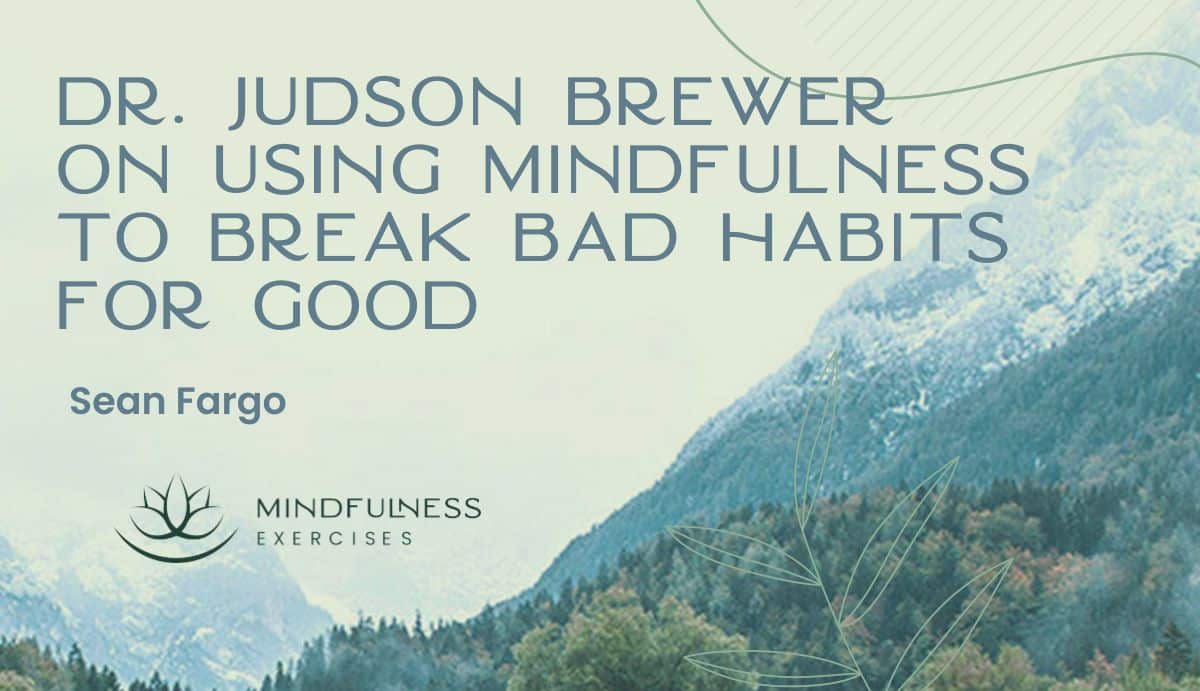Listen now

Perhaps the most significant thing we can do to improve our relationships is to be more present in our conversations. But how do we train ourselves to lead with presence, especially when the exchange is difficult?
In this episode, we hear from author and mindful communications expert Oren Jay Sofer on how being present refines both our listening and speaking skills. By practicing this, we learn to express the truth of our experience in ways others can hear, and we help them to do the same.
Oren Jay Sofer is a former Buddhist monk who teaches mindfulness, meditation and Nonviolent Communication in both secular and Buddhist communities. In a previous episode, he shared about the foundations of Mindful Communication.
This talk is a brief excerpt from Oren Jay Sofer’s live presentation to those enrolled in our Mindfulness Meditation Teacher Training Program. Learn more about this unique, online, self-paced certification program at teach.mindfulnessexercises.com
What You’ll Learn in This Episode:
Show Notes:
Training ourselves to lead with presence
The effort to bring presence to our conversations can be described as the practice of interpersonal mindfulness. We take the mindfulness we’ve cultivated in our own meditation practice and bring it to our interactions with others. Three foundational practices that can help bring presence to our relationships include grounding attention in the body, listening, and pausing.
“Another very powerful practice for leading with presence is to learn how to pause. It doesn’t need to be a long pause, it could just be half a breath, a couple of beats. But in the space of that pause, lies all the difference in the world in how you show up. Because in that pause is the capacity to choose how we respond rather than to be on automatic and react.”
Advanced practices for leading with presence
As we become more practiced in being grounded, listening and especially pausing, we may notice we have more agency over the pace of our speech. For leaders and teachers especially, the ability to intentionally modulate pace of speech is a powerful skill. And for everyone, we tend to speak more quickly when in the midst of conflict. Slowing things down has a calming effect on the nervous system, allowing for greater opportunity to connect with others and de-escalate situations.
“If you’re activated in a conversation, you feel frightened, you feel tense, you’re anxious, or worried. You’re noticing a tendency to want to control things or get defensive, there’s energy flowing through your nervous system, right? You’re activated. [...] If you slow the pace of your speech down, even just a little bit, that’s going to slow your breathing down, which is going to have a calming effect on your nervous system. So, [that’s] another very powerful way to lead with presence.”
Common anchors for grounding in the body
In mindfulness practice we learn to rest our attention on an anchor. When leading conversations with presence, Oren suggests noticing gravity’s effects on the body and anchoring awareness on the body’s central axis. In addition, awareness of breath and high sensation areas, such as hands and feet or lips and tongue, can help keep us present while conversing with others.
“One of the first practices is learning how to ground your attention in the body. The body doesn’t go into the past or the future, it’s always right here. So the more we can have some attention with our felt experience in the moment, the more present we are. [...] We can train ourselves on one reference point that is accessible in conversation. You don’t need to use all of them, you only need one.”
Why the intention to understand is of utmost importance
In conversation, when we authentically come from a place of curiosity, we create trust. We all know what it feels like to communicate with someone who seems uninterested in truly hearing us. Conversely, we intuitively recognize when a conversation partner is offering us genuine kindness. Caring curiosity can change the whole tone of a conversation, especially the most difficult ones.
“If we’re really coming from an intention to understand, we’re really getting curious, wanting to understand the other person, that starts to build not only the relationship but the essence of what we’re actually talking about. And the more understanding we have in the conversation, the easier it is to find solutions.”
Why mindful listening is just the first step
The goal of any conversion is to get to a level of shared understanding. Listening is a tool for building understanding over time, but it’s just a first step. We complete the communication cycle when we ensure that a message sent was a message received. The second step in listening is to confirm we’re hearing accurately.
“How do we confirm that message sent equals message received? If we’re not doing this, we don’t know if we’re actually understanding each other. So, listening starts to open the space up for understanding, but then what we want to do is we want to make sure that we’re hearing accurately. If I say something and then I say to you ‘do you understand’ and you say ‘yes,’ I don’t know if you actually understood. All I know is that you think you understand.”
Going beyond active listening
Oren suggests ‘offering a reflection’ as a means of ensuring that what we’ve heard indeed reflects someone’s intention. Mirroring back what has been said is just one way we can go beyond ‘active listening’ by reiterating the intention to understand. Slowing down enough to confirm if we’re really connecting and hearing each other is the fundamental building block of communication.
“This is not a communication technique. [...] This is about genuinely wanting to understand. So, the intention, the aim is, did I hear right? I’m checking. I’m not telling you what you said, that’s patronizing, I’m checking if I’ve understood. Did I hear right? I want to make sure I understood. That’s one aim. The other aim, how can I help you feel heard? How can I signal through word, gesture, tone, that I’m with you, that I've understood. How can I give you the relief of feeling heard? These are the aims behind offering a verbal reflection. And this verbal reflection, this is an expression of that intention to understand.”
Refining our speaking, as well as our listening
Mindful listening is perhaps the easy part when compared to mindful speaking. When verbalizing our needs in a conversation, how do we say what we actually mean? In this area, a personal mindfulness practice goes a long way. Oren proposes we ask ourselves three questions to get to the core of what we really want to communicate. Most of us stop with the first, ‘what do I want to say?’ But to lead with presence, we can go further.
“Ask yourself what do I want the other person to know? What is it I want them to understand? Not just what I want to get off my chest, communication is about building understanding. So what is it you want them to understand? [...] Then the last question is, how can you say it in a way that they can hear?”
Why mindful communication requires practice
Most of us understand that listening is fundamental to communication, but it becomes harder to do when the conversation is challenging, or when we feel triggered. The more we intentionally train in mindful communication, the more likely we are to maintain the practice when the going gets tough. It takes practice to go against the tide of habitual reactivity and instead, to pause and change the dynamic.
“The question is, have we trained ourselves to remember, to learn, how to listen when we’re triggered, when we’re activated, when we’re defensive, when we’re stuck in our ideas about what should have happened, and who’s right and who’s wrong. It’s easy when we’re in a good mood and we’re feeling loving. That’s not when we need the skills.”
Additional Resources:

About Oren Jay Sofer
Oren Jay Sofer is a former Buddhist monk who teaches Insight meditation and mindful communication both in person and online. He is the author of Say What You Mean: A Mindful Approach to Nonviolent Communication, which is a practical guidebook for having more effective, satisfying conversations. Oren’s innovative communication training and courses integrate Marshall Rosenberg’s work on Nonviolent Communication (NVC) with mindfulness practice.
Oren has a degree in Comparative Religion from Columbia University and is a long-time student of Joseph Goldstein, Michele McDonald, and Ajahn Sucitto. He is a graduate of the Spirit Rock Vipassana Teacher Training and a current member of the Spirit Rock Teachers Council.






